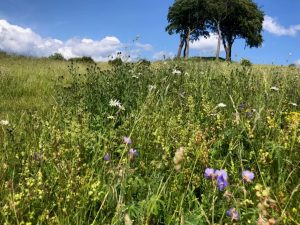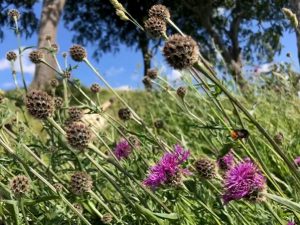…blog by Rachel Richards, Buglife B-Lines Officer. Join Rachel to find out how Copt Hill, an historic B-Lines project site, is doing eight years after the funded project ended.
Celebrate this year’s National Meadows Day by learning about a B-Lines project in England!
One of my favourite things at this time of year is walking through a flower-filled meadow; grasses heavy with pollen, bright yellow buttercups, the pinks of Red Clover and blues of Germander Speedwell and cranesbills all swaying in the breeze, hearing the buzz of busy bees and hoverflies and chasing after butterflies in an attempt to get a better look. I love a flower-rich meadow, as do insects, birds and other wildlife but as any farmer lucky enough to have one will tell you, a good meadow takes time and the correct management if it is to flourish.

In May this year we returned to visit Copt Hill in Sunderland, NE England, an historic B-Lines project site managed by Sunderland Council that Buglife worked on alongside Durham Wildlife Trust back in 2015. All B-Lines project sites are signed up to a 10-year management plan but we are keen to see, on the ground, how sites develop after projects come to an end.
Copt Hill was looking fantastic! A flower-rich hillside with scattered scrub, woodland below and topped with an ancient scheduled monument, the Seven Sisters round barrow with 6 old Beech trees growing on its brow. The grassland at Copt Hill includes examples of both lowland meadow and magnesian limestone grassland, both increasingly rare habitats. Despite the early date of the visit, we recorded 56 species of plants. This included both Common and Greater Knapweed, Birds-foot Trefoil, Yarrow, Angelica, Burnet Saxifrage, Salad Burnet, Yellow Rattle, Common Vetch and Bee Orchids. Such a diverse grassland with scattered scrub and neighbouring woodland will inevitably support a good diversity of invertebrates and other wildlife, but even more so if it is a part of a network of connected sites. This is at the heart of B-Lines, creating insect super-highways of connected sites where invertebrates are able to move freely through the countryside.
Below the barrow, areas of shallow soil, supported the most species rich areas of magnesian limestone grassland. Habitat enhancement works prior to 2015 had turf-stripped the ground here creating thin, nutrient poor soils over magnesium limestone, perfect conditions for this grassland community. Here Hoary Plantain, Field Scabious and Kidney Vetch, species characteristic of this grassland, were also present. In 2015 the Making a B-Line for the North East project cleared large areas of dense scrub from the site and collected green hay (fresh hay full of ripe seed) from small species-rich areas within the site then spread this onto newly scarified areas on the slopes helping to spread plants across the sites. In 2021 The Durham Wildlife Trust project Healing Nature cleared small saplings from the site, helping to keep the site open.

So why is this grassland flower-rich while others aren’t? Grassland needs the correct management. Back in prehistoric times Aurochs, Wild Bison and other wild herbivores managed grassland, roaming around grazing, knocking back scrub then moving on in response to food availability and predators like Wolves. This resulted in a matrix of different habitats being created and some areas always being left to flower, perfect conditions for pollinators, other invertebrates and wildlife in general. These large herbivores we now realise, are ecosystem engineers and are, where practical, replaced in management practices with other grazing animals. Where sites cannot be grazed, scrub will inevitably encroach and nutrient levels build up resulting in sites being taken over by tough grasses and scrub, losing much of their diversity. Winter grazing or a hay cut/cut and collect, is needed to allow grassland to flower through the summer supporting an abundance of life, and the grazing/hay cut keeps nutrient levels low so wild flowers can flourish.
At Copt Hill the work of various organisations and project over the years, together with fencing and winter grazing introduced by Sunderland Council, has resulted in this beautiful flower-rich grassland teeming with life. What’s more this is a site enjoyed not just by wildlife but by the local community.
B-Lines is about creating, restoring and connecting up flower-rich habitat across the UK for pollinators, wildlife and people. We all benefit from time in nature and should be able to access nature if we wish, so let’s create more flower-rich areas where we live, whether it’s helping to manage a community meadow, a road verge or planting pollinator friendly plants on a balcony. Every little bit helps.
Please visit B-Lines – Buglife to add your work to the map.
